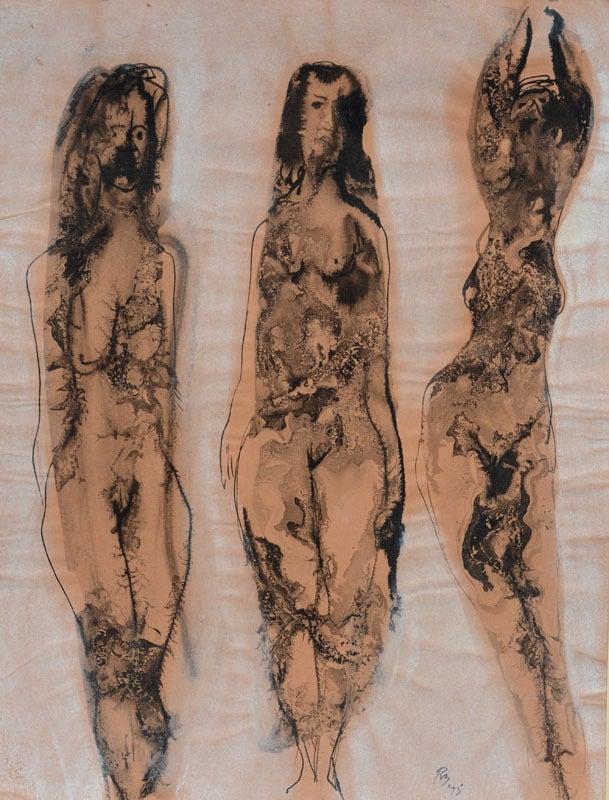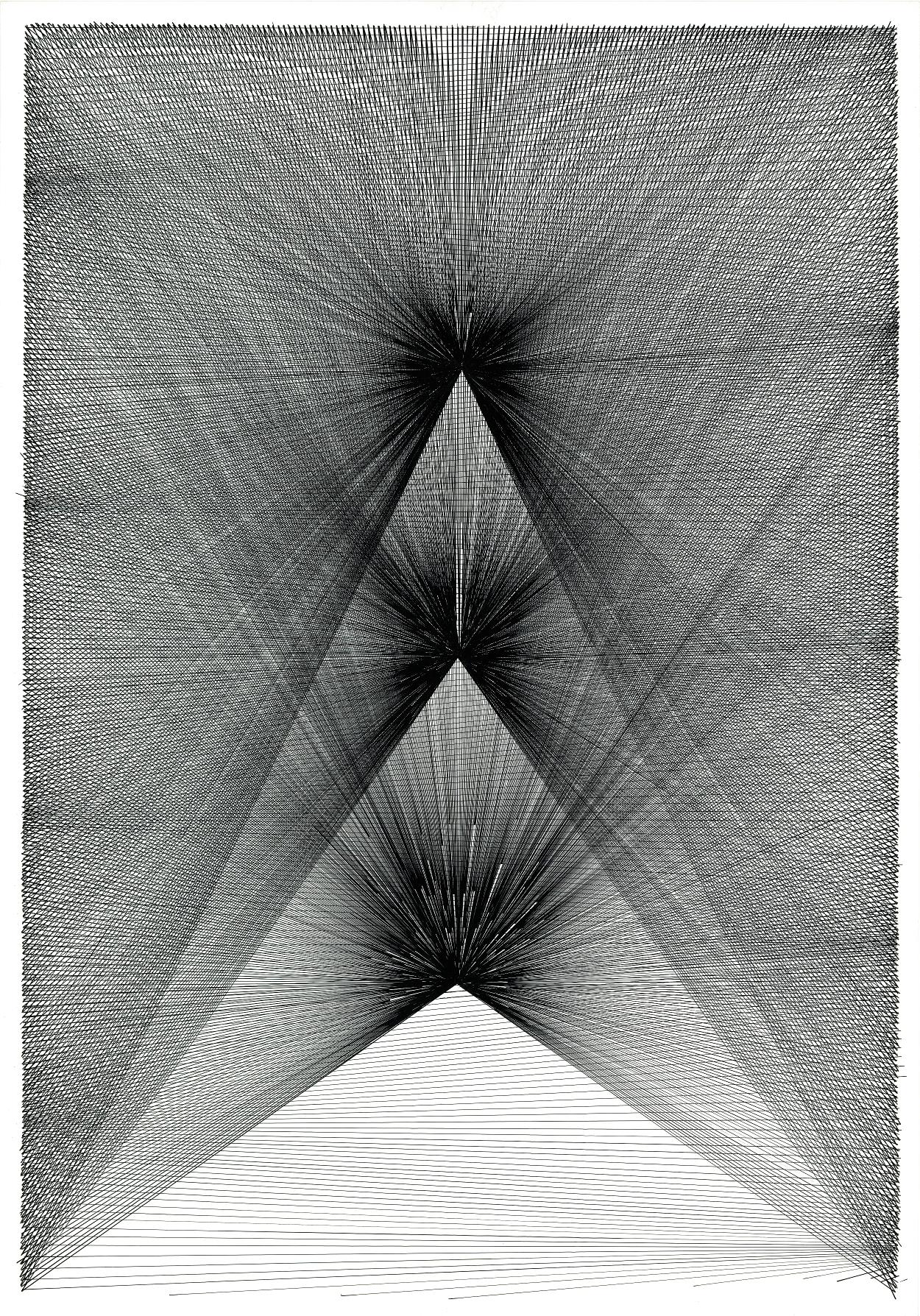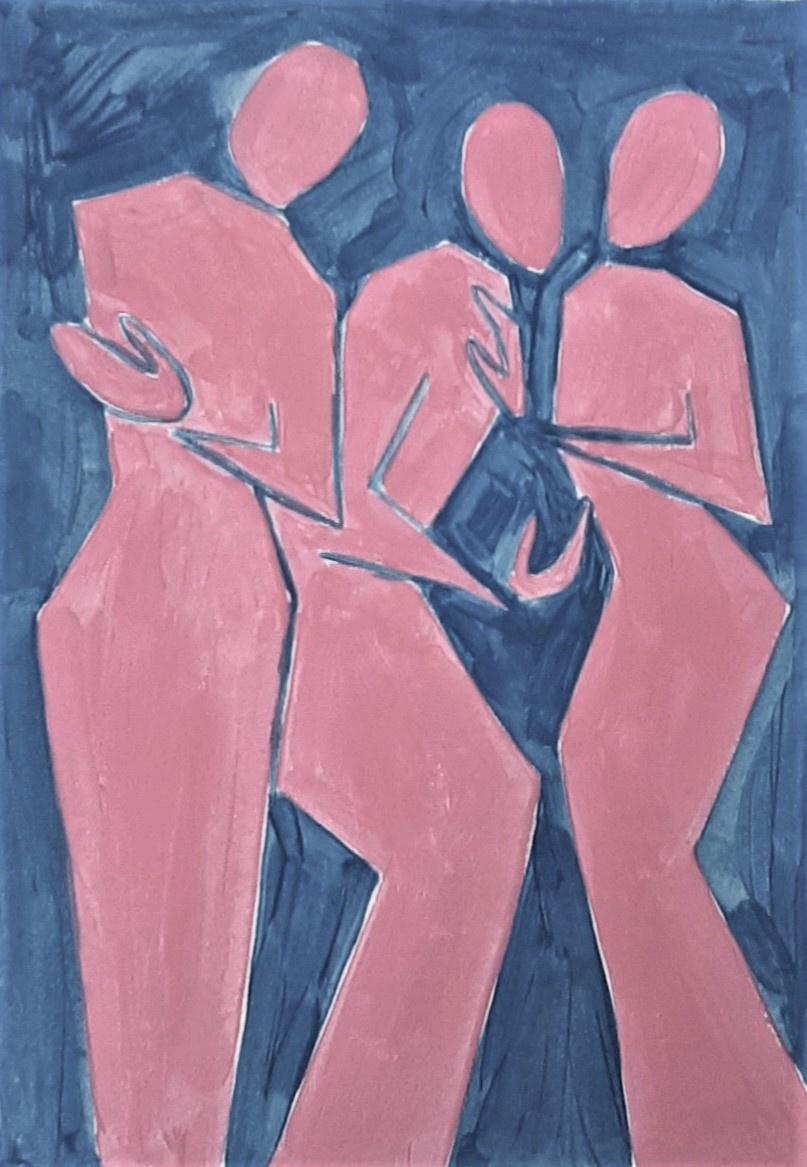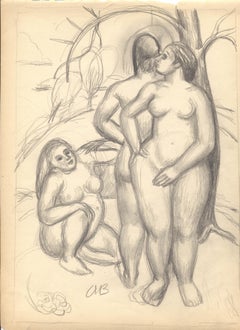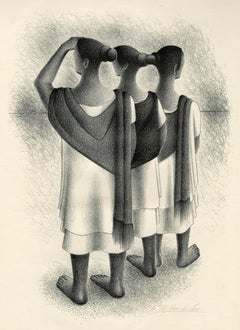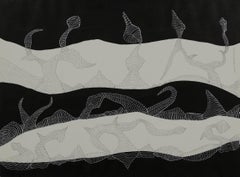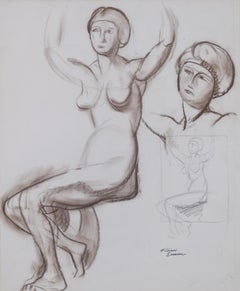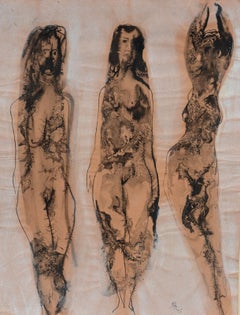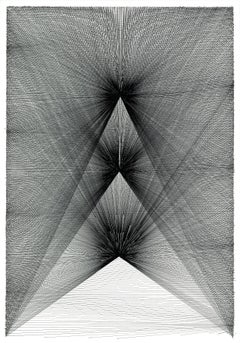Items Similar to Three Graces
Want more images or videos?
Request additional images or videos from the seller
1 of 14
Ray H. FrenchThree Graces1965
1965
$3,500
£2,653.48
€3,058.76
CA$4,929.19
A$5,466.11
CHF 2,872.03
MX$66,786.52
NOK 35,933.05
SEK 33,729.31
DKK 22,834.26
About the Item
Three Graces
Pentel marker on paper, 1965
Signed and dated by the artist lower left (see photo)
Part of a series of 100 drawings, this number 97 (annotated lower right corner)
Condition: Excellent
Sheet/Image size: 20 x 15 inches
Provenance: Estate of the Artist
Martha A. French Trust
Ray H. French: The Evolution of an Artistic Innovator
Printmaker, painter, and sculptor Ray H. French was born in Terre Haute, Indiana on May 16, 1919. Terre Haute was a cultural wasteland before the opening of the Sheldon Swope Art Museum in 1942. Thus, with a father as a coal miner and carpenter, art remained a luxury for Ray. Nevertheless, local art teachers Mabel Mikel Williams and Nola E. Williams helped to foster his creativity and unshakable drive to create things of beauty.
After high school, Ray attended the John Herron School of Art in Indianapolis. His studies there were interrupted by the outbreak of World War II, during which he developed surveillance photographs for the Army Air Force. After the war, Ray transferred to the University of Iowa on the G.I. Bill, where he received both his BFA and MFA degrees. The University of Iowa during the 1940s was a cultural mecca with many major art historians and artists. While in Iowa, Ray played an important role in this culture by becoming a founding member of the Iowa Print Group under Mauricio Lasansky.
Following his graduation in 1948, Ray experienced firsthand the rapid rise in creative printmaking in America. By 1949, he had exhibited at The Brooklyn Museum, the Walker Art Center, and MOMA New York. Ray’s early style of printmaking is characterized by pure line engraving on copper plates, a technique suited perfectly to his study of the beauty of animals. This charming and whimsical subject ran counter to the concurrent trends of Lasansky’s horrors of war and Hayter’s non-objectivity, but was equally effective in capturing the public’s attention. Walruses was purchased by the Victoria and Albert Museum, exhibited at MOMA New York and received the Arthur D. Allen Memorial Purchase Prize for its “skillful and economic use of line.” Shortly thereafter, Ray’s treatment of animals developed further into larger format mixed intaglio prints utilizing hard ground, soft ground, etching, and engraving, as exemplified in The Swan.
By the late 1950s, Ray’s style evolved into organic non-objectivity, in which he incorporated personal autobiographical vignettes and symbolism. His work during this time was further characterized by a departure from the traditional squared compositional format to his cutting and rounding of the plate to accentuate organic shapes. Ray’s 1959 Enchantment remains particularly illustrative of his use of etching and soft ground intaglio. Enchantment was successfully exhibited at the Brooklyn Museum of Art for the 12th National Print Exhibition of The American Federation of the Arts and received the Pennell Purchase Prize from the Library of Congress in 1960.
In the 1960s, Ray also started to focus on blind embossing, which he had first experimented with at the University of Iowa. He was extremely prolific and successful with this medium, selling hundreds of prints in small editions of 10 through the Associated American Artist Gallery in New York. In 1966, Ray built upon his mastery of embossing and began developing a shadow box presentation called a graphic construction that combined color, blind embossing, and multi-layered cutouts to revel intaglio compositions. Noted curator William Lieberman purchased Ray’s masterpiece graphic construction, Moon Rays, on the behalf of MOMA New York and another impression was gifted to the University of Iowa Museum of Art by Alan and Ann January in 2004.
Throughout his artistic career, Ray was also a professor and administrator at DePauw University, which occupied much of his time. Outside of his creative expression, Ray was most proud of his teaching and influencing students to find beauty in their daily lives. Specifically, he was a particularly fervent advocate of printmaking and joined the ranks of many of Lasansky’s students who went on to establish printmaking programs and departments and to further lift the stature of intaglio printmaking. During Ray’s time at DePauw, he received grants to travel around Europe. His yearlong stay in Florence led to a series of etchings, drypoints, and woodcuts of Italian and Etruscan subjects and provided inspiration for many years.
In 1984, Ray retired from his university service to work in a private studio behind his home on DePauw’s campus. After several life threatening illnesses, Ray decided to return to his early creative style of realist depictions of nature and landscape. Eventually, Ray’s health deteriorated further with the onset of macular degeneration. Legally blind, he continued to create art until shortly before his death in 2000 at the age of 80. “Sometimes when I look at a work I create, I am amazed at what inspired it. I ask myself, how on earth did I create this?” said Ray once. Ultimately, this quest to find beauty and create inspiring works of art provided the greatest source of Ray’s happiness and fulfillment, evidenced by the breadth and quality of his artistic legacy.
- Creator:Ray H. French (1919-2000, American)
- Creation Year:1965
- Dimensions:Height: 20 in (50.8 cm)Width: 15 in (38.1 cm)
- Medium:
- Movement & Style:
- Period:
- Condition:
- Gallery Location:Fairlawn, OH
- Reference Number:Seller: FA84371stDibs: LU14012255232
About the Seller
5.0
Recognized Seller
These prestigious sellers are industry leaders and represent the highest echelon for item quality and design.
Platinum Seller
Premium sellers with a 4.7+ rating and 24-hour response times
Established in 1978
1stDibs seller since 2013
809 sales on 1stDibs
Typical response time: <1 hour
Associations
International Fine Print Dealers Association
- ShippingRetrieving quote...Shipping from: Fairlawn, OH
- Return Policy
Authenticity Guarantee
In the unlikely event there’s an issue with an item’s authenticity, contact us within 1 year for a full refund. DetailsMoney-Back Guarantee
If your item is not as described, is damaged in transit, or does not arrive, contact us within 7 days for a full refund. Details24-Hour Cancellation
You have a 24-hour grace period in which to reconsider your purchase, with no questions asked.Vetted Professional Sellers
Our world-class sellers must adhere to strict standards for service and quality, maintaining the integrity of our listings.Price-Match Guarantee
If you find that a seller listed the same item for a lower price elsewhere, we’ll match it.Trusted Global Delivery
Our best-in-class carrier network provides specialized shipping options worldwide, including custom delivery.More From This Seller
View AllThree Nudes in a Garden
By Aaron Bohrod
Located in Fairlawn, OH
Three Nudes in a Garden
Graphite, c. 1928-1933
Initialed in pencil lower left (see photo)
Illustrated: Elliott & Wooden, Aaron Bohrod: Figure Sketches, Fige 9, page 32 (see photo)
A...
Category
1920s American Modern Nude Drawings and Watercolors
Materials
Graphite
Mayan Trio
By Francisco Dosamantes
Located in Fairlawn, OH
Mayan Trio
Lithograph, 1950
Signed in pencil lower right (see photo)
Edition 250 for Associated American Artists
Publsihed 1950
Reference: AAA Cat.: 1950‑05; 1958‑01
AAA Index 1087
Condition: Excellent
Image size: 13 x 9 1/2 inches
Francisco Dosamantes (b. October 4, 1911 - d. July 18.1986) was a Mexican artist and educator who is best known for is educational illustrations and graphic work against fascism. He was a founding member of the Taller de Gráfica Popular and the Salón de la Plástica Mexicana.
Life
Francisco Dosamantes was born in Mexico City on October 4, 1911. His father was Daniel Dosamantes who was a builder, interior decorator and painter. He was not registered into the civil registry until he was about twenty years old on March 6, 1939. His mother’s name is not listed on the certificate. As a child, he demonstrated a strong interest in drawing and color, influenced by his father and his uncle Juan. The Mexican Revolution occurred while he was a young child and he stated that he remembered events such as soldiers on horses charging as well as the execution of rural farm workers.
He attended primary and high school in Mexico City but stated that his education was irregular and deficient. He then entered the Escuela Nacional de Artes Plásticas, where he studied for five years. Initially, however, he was disappointed with the inexperience of the young professors and he left for a short time to study on his own. During this time, some of the dissatisfied professors organized the 30 30 group against the academic system of the school and which whom he sympathized. The effort gained the attention of established artists such as Diego Rivera who intervened.
He died on Mexico City on July 18, 1986
Career
After he graduated, he worked with the cultural missions of the Secretaría de Educación Pública in Oaxaca, Michoacán, Guerrero, Colima, Coahuila and Chihuahua (state) from 1932 to 1937 then again from 1941 to 1945. He stated that this experience was vital to his conscience as he worked with rural farm workers and others he stated were worthy of dignity and respect, but victims of deceit and exploitation. When he returned to Mexico City, he gave classes in high schools from 1937 to 1941. In 1945 he founded and directed the Taller Escuela de Dibujo y Pintura “Joaquín Claussell” in Campeche, Campeche.
Dosamantes was a politically and culturally active artist with most of his work and affiliations related to such. He was a member of the Liga de Escritores y Artistas Revolucionarios from 1934 to 1938. He was a founding member of the Taller de Gráfica Popular, serving as administrator in 1940 and remaining a member until his death except for one short hiatus. He created posters for conferences about fascism and Nazism such as Alemania bajo bayonetas (Germany under bayonets) in 1938. In 1940 he became the secretary general of the Sindicato de Maestros de Artes Plásticas. He was also a member of the Sociedad para el Impulso de las Artes Plásticas en 1948, a founding member of the Salón de la Plástica Mexicana in 1949 and a member of the Frente Nacional de Artes Plásticas from 1952.
He painted a number of murals in rural areas of Mexico generally when he was there on cultural missions. His main mural is at the former home of José María Morelos in Carácuaro, Michoacán, but there are a number at various rural schools. These were all painted between 1941 and 1946.
As a book illustrator he mostly worked for the Secretaría de Educación Pública working on books for literacy campaigns.
He exhibited his works, which included engravings, oils, tempuras and lithographs in Mexico and abroad. His first individual exhibition was in 1930 at the Galeria de Arte Moderno in Mexico City. His major exhibitions include the Excelsior Gallery in Mexico City in 1932, various exhibitions in New York, Washington, Philadelphia and Los Angeles in 1937; the Nelson Gallery of Art in Kansas City, Missouri in late 1947, and the Gallery of Mexican Art in...
Category
1950s American Modern Figurative Prints
Materials
Lithograph
Sea Forms
By Ray H. French
Located in Fairlawn, OH
Signed and dated center right edge; Annotated "48" lower left
Provenance:
Estate of the artist
One of a suite of 120 drawings that the artist did in 1 month.
Most were sold thro...
Category
1960s Abstract Abstract Drawings and Watercolors
Materials
Ink, Pen
Female Nude Study
By William Sommer
Located in Fairlawn, OH
Female Nude Study
Graphite and crayon on wove paper, c. 1928
Signed with the Estate stamp "B" (see photo)
Provenance: Estate of the Artist
Edward Sommer (his so...
Category
1920s American Modern Nude Drawings and Watercolors
Materials
Crayon
Female Torso, Nude
By Asa Cheffetz
Located in Fairlawn, OH
Nude Female Torso
Charcoal on paper, c. 1920
Stamped and initialed in pencil "Asa Cheffetz/A.D.C"
Estate signature by wife, A.D.C.
Exhibited: Museum of F...
Category
1920s American Realist Nude Drawings and Watercolors
Materials
Charcoal
Untitled
By Matthew Kolodziej
Located in Fairlawn, OH
Untitled
Watercolor, cut out and construction on paper, 2013
Signed and dated in pencil lower right
Condition: Excellent
Image size: 22 x 30 inches
Frame size: 30 x 37 inches
Archiv...
Category
2010s Contemporary Abstract Drawings and Watercolors
Materials
Watercolor
You May Also Like
Three Graces
By Ron Blumberg
Located in West Hollywood, CA
American artist Ron Blumberg was classically trained at La Grande Academie Chaumiere in Paris, 1932, before moving to New York where he became a National Academy artist and a member of the Art Students League.
"Three Graces...
Category
1940s Figurative Drawings and Watercolors
Materials
Mixed Media
Price Upon Request
Three Graces
Located in Toronto, ON
36" x 23.5" Unframed
Limited Edition Hand Pulled Silkscreen with Hand Embellishment of 300
Hand Signed by R.J. Hohimer
Category
21st Century and Contemporary Figurative Prints
Materials
Screen
$2,550
Three Graces
Located in Bozeman, MT
Daphne Sweet, artist working and living in Missoula, Mt. Using acrylic, oil, clay, and fabric.
Bouncing between classical references and personal allegory, the paintings and found ...
Category
2010s Contemporary Figurative Paintings
Materials
Canvas, Acrylic
My three graces, Drawing, Pen & Ink on Paper
By Andrew Bator
Located in Yardley, PA
I was fascinated with a woman's body, I wanted to show the interpretation of love act, the emotions behind it. :: Drawing :: Abstract :: This piece comes with an official certificate...
Category
2010s Abstract Abstract Drawings and Watercolors
Materials
Pen
Three Nude Figures - Pencil Drawing by Leo Guida - 1970s
By Leo Guida
Located in Roma, IT
Three Nude Figures is an original Contemporary artwork realized in the 1970s by the italian artist Leo Guida.
Original Pencil Drawing on paper.
Mint conditions.
Leo Guida. Sensi...
Category
1970s Contemporary Figurative Drawings and Watercolors
Materials
Paper, Pencil
Three Graces - Figurative Painting on Paper, Young art Minimalism, Vibrant
By Waleria Matelska
Located in Warsaw, PL
WALERIA MATELSKA (born 1994 in Belarus)
In 2012-2015 she studied at the Faculty of Painting at the Academy of Fine Arts in Krakow, where in the years 2015-2018 she her diploma from t...
Category
21st Century and Contemporary Contemporary Abstract Paintings
Materials
Paper, Acrylic
